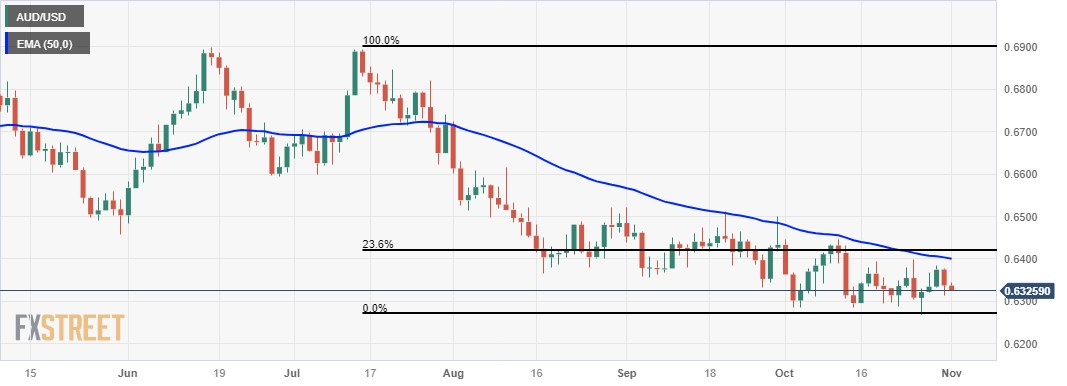- Australian Dollar extends losses after weaker economic data on Wednesday.
- Australia’s AiG Industry Index came in at -9.9, while Building Permits declined by 4.6%.
- China's Caixin Manufacturing PMI dropped to 49.5 in October against September’s expansion of 50.6.
- IMF contends that the RBA should consider further policy tightening as inflation proves stubborn.
- Higher US Treasury yields support the advance of the US Dollar ahead of the Fed decision.
The Australian Dollar (AUD) extends its losses for the second session, hovering around a key level on Wednesday. The AUD/USD pair faces downward pressure due to the subdued economic data from Australia, coupled with a stronger US Dollar (USD) ahead of the Federal Open Market Committee (FOMC) policy decision.
Australia’s economic data released on Wednesday, featuring the AiG Industry Index and Building Permits (MoM) for September, indicated a downturn. Nevertheless, the Aussie Dollar found reinforcement on Monday, courtesy of robust Retail Sales, which surprised the market by posting a higher reading in September.
Reserve Bank of Australia (RBA) is poised to unveil its policy decision on November 7. Anticipations lean towards a 25 basis points increase in interest rates during the upcoming meeting, driven by heightened inflation.
China's Caixin Manufacturing Purchasing Managers' Index (PMI) took an unexpected dip in October as revealed in the latest Wednesday data. This downbeat performance in Chinese Manufacturing PMI contributes to additional pressure on the Aussie Dollar.
International Monetary Fund (IMF) emphasized Australia's economic resilience in its yearly evaluation, even as inflation proves stubborn. The IMF contends that the Reserve Bank of Australia (RBA) should consider further policy tightening. Australia's economy, after a robust post-pandemic rebound, is experiencing a slowdown but continues to demonstrate resilience.
The US Dollar Index (DXY) continues to gain ground for the second day, propelled by higher US Treasury yields as the market braces for the upcoming policy decision by the US Federal Reserve (Fed). While expectations suggest the central bank will likely uphold its current monetary policy stance in the Wednesday meeting, the outlook for December's gathering hinges on data-driven considerations.
Investors are poised to closely monitor the Federal Open Market Committee's (FOMC) post-meeting message, seeking valuable cues for market participants gauging the potential trajectory of interest rates.
Daily Digest Market Movers: Australian Dollar trades lower on the subdued economic figures ahead of the Fed policy decision
- Australia’s AiG Industry Index for September declined to -9.9 against the previous reading of -3.5, while Building Permits (MoM) declined by 4.6% against the market consensus of a 1.3% rise, swinging from the previous growth of 7.0%.
- Australia's Retail Sales (Month-on-Month) soared to 0.9% in September, surpassing market expectations of 0.3% and the previous figure of 0.2%.
- Australian Consumer Price Index (CPI) for the third quarter of 2023 reached 1.2%, exceeding both the 0.8% uptick in the previous quarter and the market consensus of 1.1% for the same period.
- The Reserve Bank of Australia stated heightened concern about the inflation impact stemming from supply shocks. Governor of the Reserve Bank of Australia, Michele Bullock stated that if inflation persists above projections, the RBA will take responsive policy measures. There is an observable deceleration in demand, and per capita consumption is on the decline.
- China's Caixin Manufacturing Purchasing Managers' Index (PMI) dipped to 49.5 in October, contrasting with September's expansion at 50.6, as revealed in the latest Wednesday data.
- The Chinese Purchasing Managers' Index (PMI) data released on Tuesday has sparked concerns about the sluggish economic state of the world's second-largest economy. With Australia being China's largest trading partner, there's a heightened possibility of this development influencing the Australian Dollar.
- China's NBS Manufacturing PMI took an unexpected turn in September, contracting to 49.5, down from the 50.2 expansion observed in July and falling short of the market consensus of 50.2.
- Chinese NBS Services PMI also experienced a decline, dropping to 50.6 in September compared to the anticipated figure of 51.8 and the previous reading of 51.7.
- According to reports, there's a tentative agreement between the US and China for a meeting between Presidents Joe Biden and Xi Jinping in November. This comes after months of strategic diplomatic efforts to mend relations.
- US Core Personal Consumption Expenditures Price Index (YoY) saw a slight decline to 3.7% from the previous reading of 3.8%. However, the monthly index showed an increase to 0.3%, in line with expectations and up from 0.1% previously.
- The University of Michigan Consumer Index surpassed expectations in October, reporting a figure of 63.8, which was expected to remain consistent at 63.0.
- Investors will focus on the key indicators such as the US ADP Employment Change, and ISM Manufacturing PMI for October ahead of the Fed policy decision, with expectations of the interest rates to be kept at 5.5% in the upcoming meeting on Wednesday.
Technical Analysis: Australian Dollar hovers below 0.6350 psychological level
The Australian Dollar consolidates beneath the crucial level of 0.6350, with the annual low at 0.6270 potentially serving as a significant support, closely aligned with the major level around 0.6250. On the upside, attention is drawn to the pivotal resistance situated around the 50-day Exponential Moving Average (EMA) at 0.6400. A breakthrough above this resistance has the potential to propel the currency towards the 23.6% Fibonacci retracement level at 0.6419.
AUD/USD: Daily Chart
Australian Dollar price today
The table below shows the percentage change of Australian Dollar (AUD) against listed major currencies today. Australian Dollar was the weakest against the New Zealand Dollar.
| USD | EUR | GBP | CAD | AUD | JPY | NZD | CHF | |
| USD | 0.18% | 0.01% | 0.01% | 0.05% | 0.04% | -0.11% | -0.09% | |
| EUR | -0.19% | -0.17% | -0.15% | -0.15% | -0.14% | -0.30% | -0.27% | |
| GBP | -0.01% | 0.18% | 0.02% | 0.03% | 0.03% | -0.13% | -0.09% | |
| CAD | -0.02% | 0.17% | 0.00% | 0.03% | 0.04% | -0.11% | -0.09% | |
| AUD | -0.05% | 0.14% | -0.03% | -0.03% | 0.00% | -0.15% | -0.11% | |
| JPY | -0.05% | 0.15% | -0.03% | -0.01% | 0.00% | -0.16% | -0.13% | |
| NZD | 0.10% | 0.30% | 0.12% | 0.14% | 0.15% | 0.15% | 0.03% | |
| CHF | 0.09% | 0.27% | 0.10% | 0.10% | 0.13% | 0.14% | -0.02% |
The heat map shows percentage changes of major currencies against each other. The base currency is picked from the left column, while the quote currency is picked from the top row. For example, if you pick the Euro from the left column and move along the horizontal line to the Japanese Yen, the percentage change displayed in the box will represent EUR (base)/JPY (quote).
Australian Dollar FAQs
What key factors drive the Australian Dollar?
One of the most significant factors for the Australian Dollar (AUD) is the level of interest rates set by the Reserve Bank of Australia (RBA). Because Australia is a resource-rich country another key driver is the price of its biggest export, Iron Ore. The health of the Chinese economy, its largest trading partner, is a factor, as well as inflation in Australia, its growth rate and Trade Balance. Market sentiment – whether investors are taking on more risky assets (risk-on) or seeking safe-havens (risk-off) – is also a factor, with risk-on positive for AUD.
How do the decisions of the Reserve Bank of Australia impact the Australian Dollar?
The Reserve Bank of Australia (RBA) influences the Australian Dollar (AUD) by setting the level of interest rates that Australian banks can lend to each other. This influences the level of interest rates in the economy as a whole. The main goal of the RBA is to maintain a stable inflation rate of 2-3% by adjusting interest rates up or down. Relatively high interest rates compared to other major central banks support the AUD, and the opposite for relatively low. The RBA can also use quantitative easing and tightening to influence credit conditions, with the former AUD-negative and the latter AUD-positive.
How does the health of the Chinese Economy impact the Australian Dollar?
China is Australia’s largest trading partner so the health of the Chinese economy is a major influence on the value of the Australian Dollar (AUD). When the Chinese economy is doing well it purchases more raw materials, goods and services from Australia, lifting demand for the AUD, and pushing up its value. The opposite is the case when the Chinese economy is not growing as fast as expected. Positive or negative surprises in Chinese growth data, therefore, often have a direct impact on the Australian Dollar and its pairs.
How does the price of Iron Ore impact the Australian Dollar?
Iron Ore is Australia’s largest export, accounting for $118 billion a year according to data from 2021, with China as its primary destination. The price of Iron Ore, therefore, can be a driver of the Australian Dollar. Generally, if the price of Iron Ore rises, AUD also goes up, as aggregate demand for the currency increases. The opposite is the case if the price of Iron Ore falls. Higher Iron Ore prices also tend to result in a greater likelihood of a positive Trade Balance for Australia, which is also positive of the AUD.
How does the Trade Balance impact the Australian Dollar?
The Trade Balance, which is the difference between what a country earns from its exports versus what it pays for its imports, is another factor that can influence the value of the Australian Dollar. If Australia produces highly sought after exports, then its currency will gain in value purely from the surplus demand created from foreign buyers seeking to purchase its exports versus what it spends to purchase imports. Therefore, a positive net Trade Balance strengthens the AUD, with the opposite effect if the Trade Balance is negative.
Information on these pages contains forward-looking statements that involve risks and uncertainties. Markets and instruments profiled on this page are for informational purposes only and should not in any way come across as a recommendation to buy or sell in these assets. You should do your own thorough research before making any investment decisions. FXStreet does not in any way guarantee that this information is free from mistakes, errors, or material misstatements. It also does not guarantee that this information is of a timely nature. Investing in Open Markets involves a great deal of risk, including the loss of all or a portion of your investment, as well as emotional distress. All risks, losses and costs associated with investing, including total loss of principal, are your responsibility. The views and opinions expressed in this article are those of the authors and do not necessarily reflect the official policy or position of FXStreet nor its advertisers. The author will not be held responsible for information that is found at the end of links posted on this page.
If not otherwise explicitly mentioned in the body of the article, at the time of writing, the author has no position in any stock mentioned in this article and no business relationship with any company mentioned. The author has not received compensation for writing this article, other than from FXStreet.
FXStreet and the author do not provide personalized recommendations. The author makes no representations as to the accuracy, completeness, or suitability of this information. FXStreet and the author will not be liable for any errors, omissions or any losses, injuries or damages arising from this information and its display or use. Errors and omissions excepted.
The author and FXStreet are not registered investment advisors and nothing in this article is intended to be investment advice.
Recommended content
Editors’ Picks

EUR/USD accelerates losses to 1.0930 on stronger Dollar
The US Dollar's recovery regains extra impulse sending the US Dollar Index to fresh highs and relegating EUR/USD to navigate the area of daily troughs around 1.0930 in the latter part of Friday's session.

GBP/USD plummets to four-week lows near 1.2850
The US Dollar's rebound keep gathering steam and now sends GBP/USD to the area of multi-week lows in the 1.2850 region amid the broad-based pullback in the risk-associated universe.

Gold trades on the back foot, flirts with $3,000
Gold prices are accelerating their daily decline, steadily approaching the critical $3,000 per troy ounce mark as the Greenback's rebound gains extra momentum and US yields tighten their retracement.

Can Maker break $1,450 hurdle as whales launch buying spree?
Maker holds steadily above $1,250 support as a whale scoops $1.21 million worth of MKR. Addresses with a 100k to 1 million MKR balance now account for 24.27% of Maker’s total supply. Maker battles a bear flag pattern as bulls gather for an epic weekend move.

Strategic implications of “Liberation Day”
Liberation Day in the United States came with extremely protectionist and inward-looking tariff policy aimed at just about all U.S. trading partners. In this report, we outline some of the more strategic implications of Liberation Day and developments we will be paying close attention to going forward.

The Best brokers to trade EUR/USD
SPONSORED Discover the top brokers for trading EUR/USD in 2025. Our list features brokers with competitive spreads, fast execution, and powerful platforms. Whether you're a beginner or an expert, find the right partner to navigate the dynamic Forex market.




